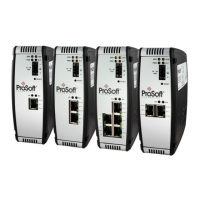ASCII Protocol PLX3x Series
User Manual Ethernet and Serial Gateways
Page 162 of 218 ProSoft Technology, Inc.
May 26, 2016
Specifies the handshaking used on the port.
No-No hardware or software handshaking
Yes-RTS/CTS hardware handshaking
DTR/DSR- DTR/DSR hardware handshaking
XON/XOFF- software handshaking
MESSAGE
TIMEOUT
INTERCHARACTER
DELAY
PACKET SIZE
Defines the receive termination characteristics for the port.
When the ASCII driver encounters the specified termination
condition on the port, it will interpret it as end of message.
Used when the Rx Termination Type is TERMINATION
CHARACTERS. This parameter specifies the number of
different termination characters that can be used to signal
the end of a received message.
Used when the Rx Termination Type is TERMINATION
CHARACTERS. This parameter specifies the termination
characters used to signal the end of each received
message. Enter up to 12 ASCII character codes in decimal
format, with spaces between codes. The number of
termination characters is set in the Rx Term Count
parameter.
Used when the Rx Termination Type is PACKET SIZE. This
parameter sets the length of data required to be received on
the port before considering end-of-message reached.
Used when the Rx Termination Type is MESSAGE
TIMEOUT. This parameter sets the number of milliseconds
to wait after the first character is received on the port before
considering end-of-message reached.
Used when the Rx Termination Type is
INTERCHARACTER DELAY. This parameter sets the
maximum number of milliseconds to wait between each
character received on the port. When this value is
exceeded, the ASCII driver considers end-of-message
reached.
Specifies if byte swapping of received data will occur.
Specifies the timeout period to transmit a message out the
port. Message transmission will be aborted if the message
is not transmitted out the port within the specified timeout
period.
Specifies the minimum number of milliseconds to delay
before transmitting a message out the port. This pre-send
delay is applied before the RTS on time. This may be
required when communicating with slow devices.
Specifies if byte swapping of transmitted data will occur.

